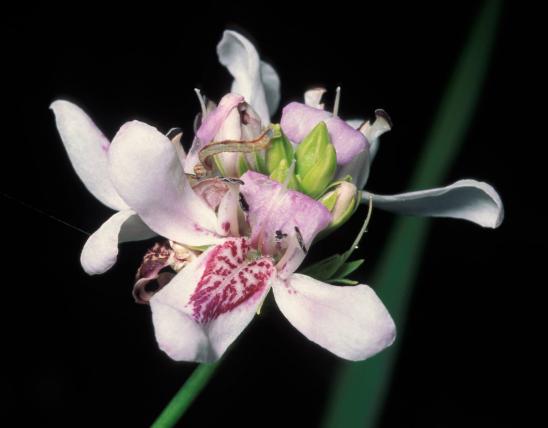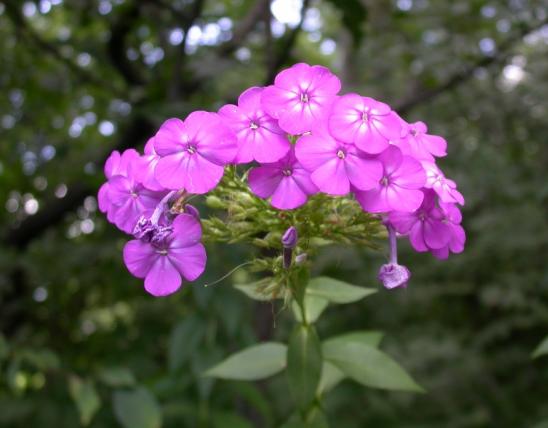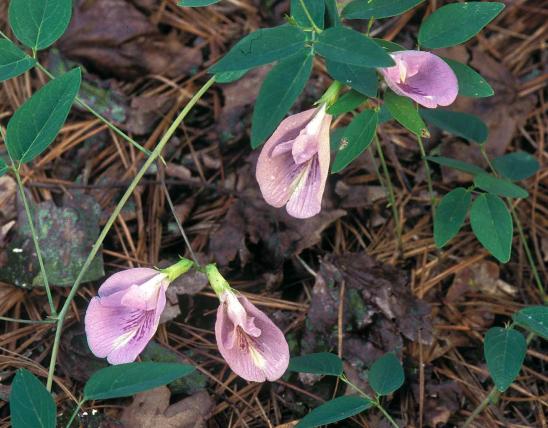
The tuberous grass pink is one of two species of grass pinks in Missouri. It lives in Ozark fens and is rare in the state. Like other orchids in genus Calopogon, its flowers seem upside down.
This herbaceous perennial grows from tuberlike corms, with erect stems bearing 3–10 pink flowers. There is usually only 1 leaf, which is basal, smooth, and linear to lance-shaped.
While most orchids have the “lip” petal (labellum) apparently positioned at the bottom of the flower (hanging downward, something like an apron), Calopogon flowers have the lip petal, with its patch of club-shaped hairs, uppermost. The flower is configured like this: 3 petal-like sepals (1 pointing down, and 2 spreading out to the sides), and 3 petals (2 angled downward on either side of the lower sepal, and the “lip,” which points upward).
The tuberous grass pink blooms June–July and can be distinguished from its close relative, the Oklahoma grass pink, by its bright, intensely pink flowers; the patch of club-shaped hairs nearest the outer tip of the lip being white, yellow, or orange (with the more basal patches usually yellow); and the flowering stem noticeably longer than the leaf. Unlike the Oklahoma grass pink, it lives in Ozark fens.
Similar species: Globally, there are five species of Calopogon, and all are found in eastern North America.
Missouri’s only other species of Calopogon is the Oklahoma grass pink or prairie grass pink (C. oklahomensis). Until 1981 it was usually considered the same as C. tuberosus, but the two live in different habitats and have somewhat different forms. The Oklahoma grass pink blooms earlier, in early May–early June. Its flowers are a paler pink, and the patch of club-shaped hairs nearest the outer tip of the lip are pale pink (with the more basal patches usually yellow). Also, the flowering stem is no longer than the leaf. It blooms at 2–8 inches high, with 2–7 flowers per stem. It is scattered in the unglaciated plains of southwestern Missouri, living in rich upland prairies, drier places than where C. tuberosus lives.
Height: 8–24 inches.
Scattered in the Ozark and Ozark border regions, particularly in Shannon, Reynolds, Iron, and St. Francois counties. Widespread in the eastern United States and adjacent Canada, west to Oklahoma.
Habitat and Conservation
Known mainly from fens, but they may also occur in moist open woods.
Fens are closely associated with groundwater, for they are where the land meets the water table. Groundwater seeps into the soil, keeping it constantly, or almost constantly, saturated or under water. Fens are a special kind of seep: they are large enough to create gaps in tree canopies (because the saturated ground inhibits tree survival), and they often create an area dominated by sedges and grasses. Fens are also called swampy meadows, wet seepy meadows, or wet calcareous meadows.
Status
Native perennial wildflower. A Missouri species of conservation concern, considered imperiled within the state. The closely related Oklahoma grass pink is also a species of conservation concern, sharing the same ranking.
Human Connections
The species name, Calopogon, is from the Greek calas (“beautiful”) and pogon (“bearded”), in reference to the hairs on the lip. The species name, tuberosus, refers to the tuberous rootstock.
People have played a large role in reducing and destroying natural orchid populations. Unscrupulous collectors have dug up our showiest species for use in gardens. Sadly, most of these die soon after transplanting because all orchids have obligate relationships with soil-borne mycorrhizal fungi and do not tolerate environmental changes well. If you are lucky enough to find orchids in the wild, enjoy them in their natural habitats. Take pictures! Treasure your memories.
Humans have also destroyed and fragmented the habitats in which orchids live, and once orchids are lost from an area, they generally never come back. Although an orchid, when pollination is successful, may produce thousands of seeds, the seeds are tiny and have no energy reserves. They must germinate in a perfect habitat and in the presence of particular kinds of symbiotic fungi in order to survive.
Over the years, Missourians have damaged or destroyed many of the state’s natural fens, or calcareous wet meadows, where tuberous grass pink lives. Early settlers drained them, introduced grazing or converted the land to crop fields, suppressed natural fires, and introduced or allowed invasive trees, shrubs, and other plants to overwhelm the delicate plant communities. Road construction, including roadcuts and fill, altered the groundwater flow, often causing fens to dry up. Overgrazing, ATV trespassing, feral hog wallows, and trenching to drain fens continue to threaten fen communities.
Ecosystem Connections
Like other orchids, the intriguing form of the flowers is related to their manipulation of pollinating insects. In this case, the flower’s upper lip acts something like a snap trap. The bright-colored hairs resemble anthers but offer no reward to the bees that are deceived by them. The hinged lip, which is at the top of the flower, flexes downward when a heavy enough bee lands on it, forcing the surprised insect to rub against the reproductive parts of the flower, pollinating it, as it struggles to escape. Various bumblebees, and some leafcutter bees, are the main pollinators.
Some have suggested that grass pinks also fool pollinators into visiting them by mimicking the color and overall look of other flowers, such as phloxes, that live nearby and do offer nectar rewards.
In Missouri, tuberous grass pink is restricted to Ozark fens. In our state, fens are special for supporting many rare plants and animals, including rose pogonia, queen of the prairie, marsh violet, shining ladies’ tresses, marsh bellflower, showy lady’s slipper, Loesel’s twayblade, sparse-lobed grape fern, and miterwort. Several dragonflies and damselflies, including the federally endangered Hine’s emerald dragonfly, are strongly associated with fens. Several lungless salamanders use fens as dry-weather refuges and as breeding sites. The swamp metalmark butterfly feeds on swamp thistle that is associated with Ozark fens.
The odd “upside-down” look of grass pink flowers sets them apart from most other orchids, where the “lip” seems to be the lowest part of the flower, hanging down like an apron. Actually, it is the majority of orchids whose flowers are upside down! In orchids, the specialized, flaring, brightly colored “lip” petal actually forms at the uppermost part of the flower bud — then, as the flower opens, the whole flower rotates, so that the lip hangs downward. Thus most orchid flowers are “resupinate” — they turn over on their backs. And orchids like the grass pinks are called non-resupinate, since they do not rotate as they open, so the lip petal remains on top. In both resupinate and non-resupinate orchids, the position of the showy lip petal is connected to the flower’s interactions with pollinating insects.


































